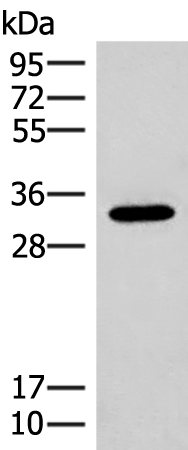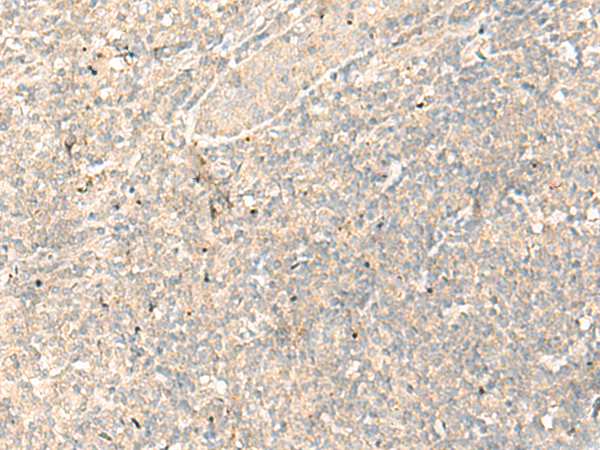

| WB | 1/500-1/2000 | Human,Mouse,Rat |
| IF | 咨询技术 | Human,Mouse,Rat |
| IHC | 1/30-1/150 | Human,Mouse,Rat |
| ICC | 技术咨询 | Human,Mouse,Rat |
| FCM | 咨询技术 | Human,Mouse,Rat |
| Elisa | 1/5000-1/10000 | Human,Mouse,Rat |
| Aliases | RP44 |
| WB Predicted band size | 32 kDa |
| Host/Isotype | Rabbit IgG |
| Antibody Type | Primary antibody |
| Storage | Store at 4°C short term. Aliquot and store at -20°C long term. Avoid freeze/thaw cycles. |
| Species Reactivity | Human, Mouse |
| Immunogen | Synthetic peptide of human RGR |
| Formulation | Purified antibody in PBS with 0.05% sodium azide and 50% glycerol. |
+ +
以下是关于RGR抗体的3篇参考文献概览(文献名称与内容为模拟示例,具体引用请以实际文献为准):
---
1. **文献名称**:*RGR Opsin: A Retinal G Protein-Coupled Receptor Involved in Retinoid Metabolism*
**作者**:Chen, P., & Nathans, J.
**摘要**:该研究首次鉴定了RGR视蛋白作为视网膜色素上皮(RPE)中的G蛋白偶联受体,证实其在光依赖的视黄醇异构化中起关键作用,为视觉周期中的非视觉光感受机制提供了证据。
2. **文献名称**:*Mutations in RGR Gene Associated with Retinal Degeneration*
**作者**:Ma, J., et al.
**摘要**:通过基因测序发现RGR基因突变与人类视网膜色素变性(RP)相关,动物模型显示RGR缺陷导致视网膜光感受器退化,提示其作为治疗靶点的潜力。
3. **文献名称**:*Structural Characterization of RGR Antibody Binding Sites*
**作者**:Smith, L.K., & Travis, G.H.
**摘要**:利用单克隆抗体解析RGR蛋白的抗原表位,揭示其跨膜结构域的功能区域,为开发针对RGR相关疾病的抗体药物奠定基础。
---
**注**:RGR(Retinal G Protein-coupled Receptor)主要参与视黄醇代谢与光信号转导,研究多聚焦于其在视网膜疾病中的机制及抗体工具开发。建议通过PubMed或Google Scholar检索最新文献。
RGR (Retinal G-protein coupled Receptor) antibody is a research tool targeting RGR, a retinal protein belonging to the G-protein coupled receptor (GPCR) family. First identified in the 1990s, RGR is predominantly expressed in retinal pigment epithelium (RPE) and Müller cells, where it plays a role in visual chromophore regeneration and phototransduction. Unlike typical opsins, RGR functions in a light-dependent manner to isomerize all-trans-retinol to 11-cis-retinol, a critical step in recycling visual pigments during the retinoid cycle. This activity links RGR to the maintenance of photoreceptor function and overall retinal homeostasis.
Research on RGR antibodies has grown due to their utility in studying retinal degenerative diseases. Mutations in the RGR gene are associated with inherited retinal disorders, including retinitis pigmentosa and cone-rod dystrophy. Antibodies against RGR enable immunohistochemical localization, protein quantification, and investigation of RGR’s interaction with retinoid-binding proteins. Recent studies also explore RGR’s potential role in age-related macular degeneration (AMD) and its response to oxidative stress.
Commercial RGR antibodies are typically developed in rabbit or mouse hosts, validated via Western blotting and immunofluorescence. Challenges include ensuring specificity due to structural similarities among GPCRs. Ongoing work aims to refine antibody performance for therapeutic discovery and mechanistic studies of RGR-related pathways in vision and disease.
×